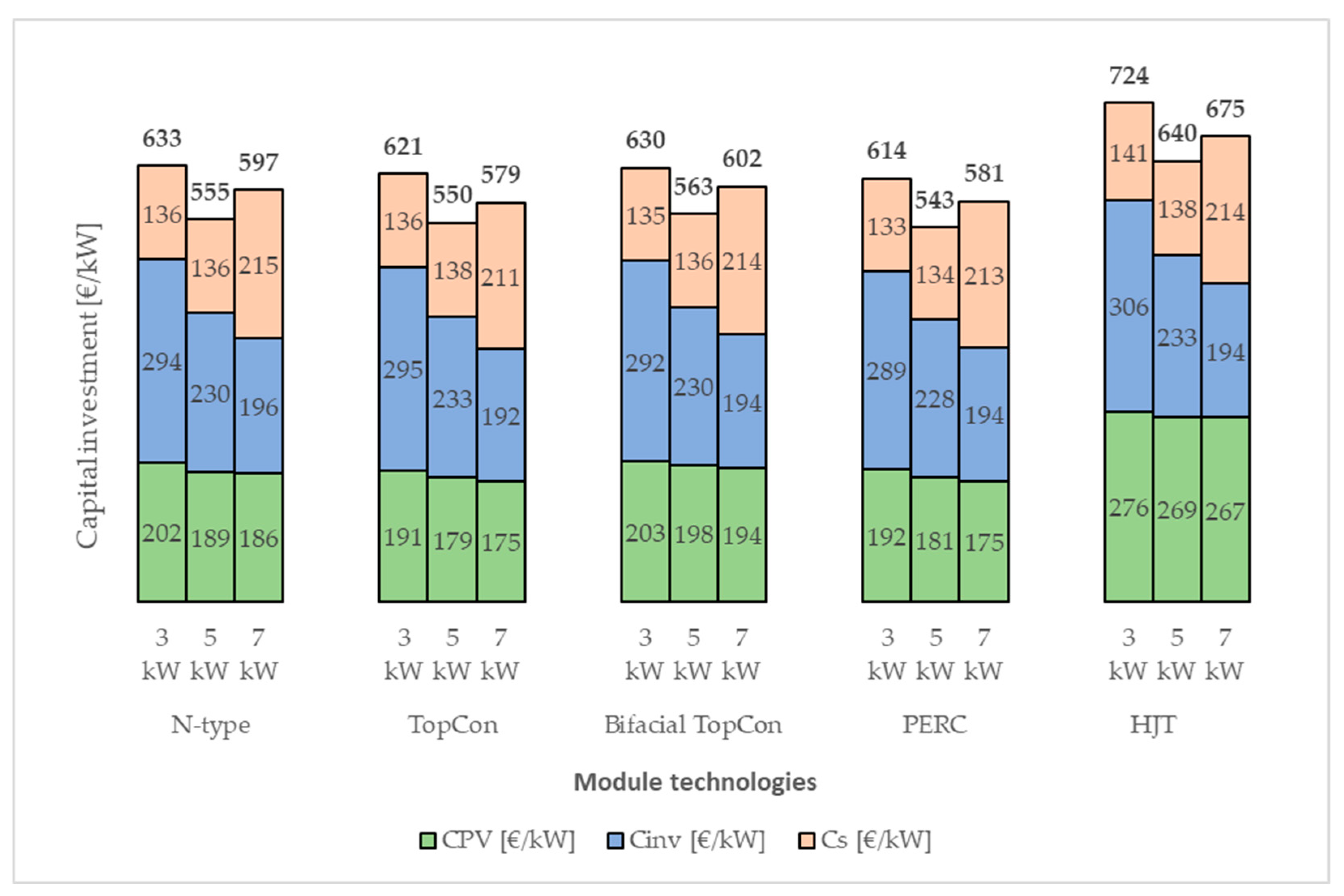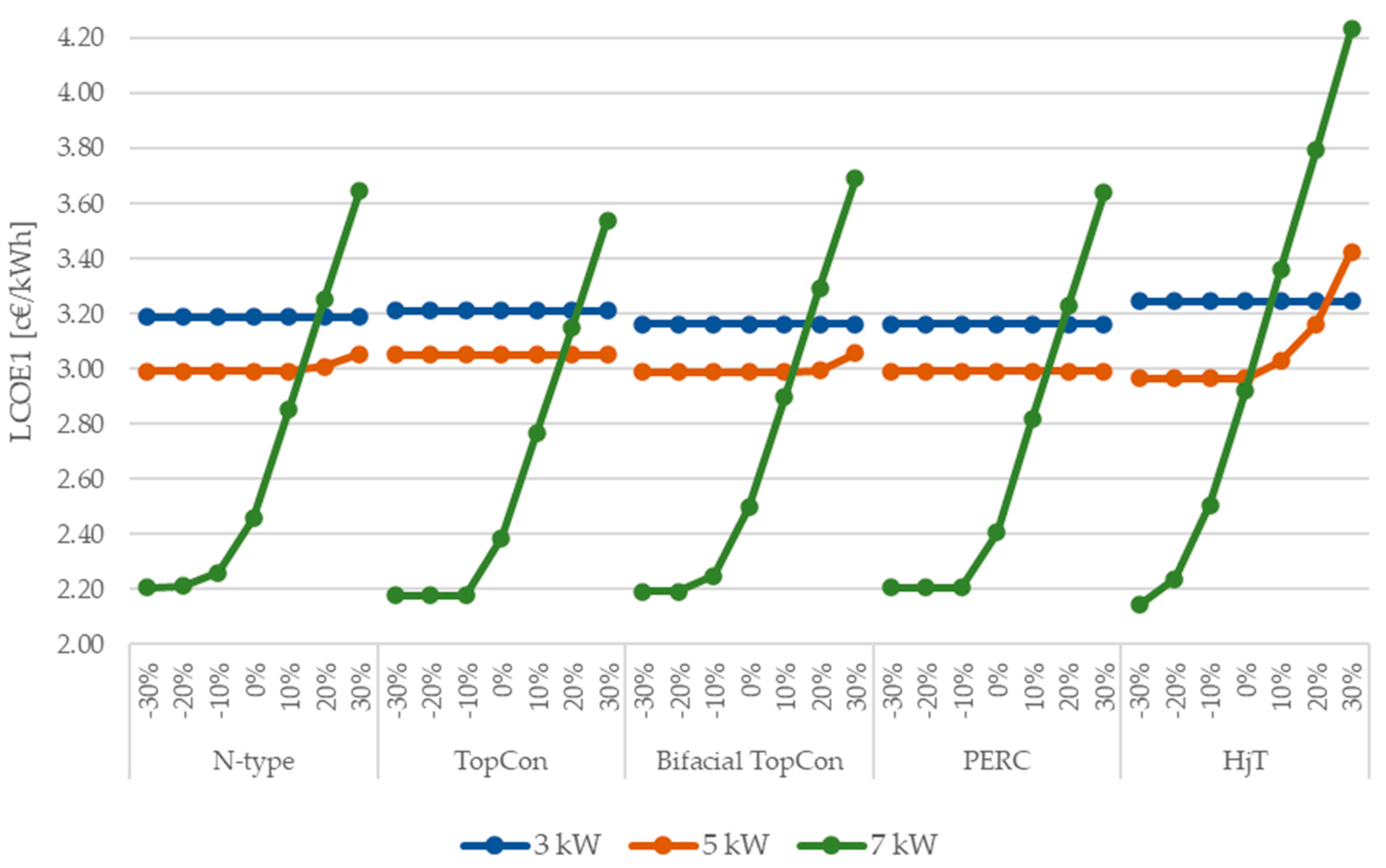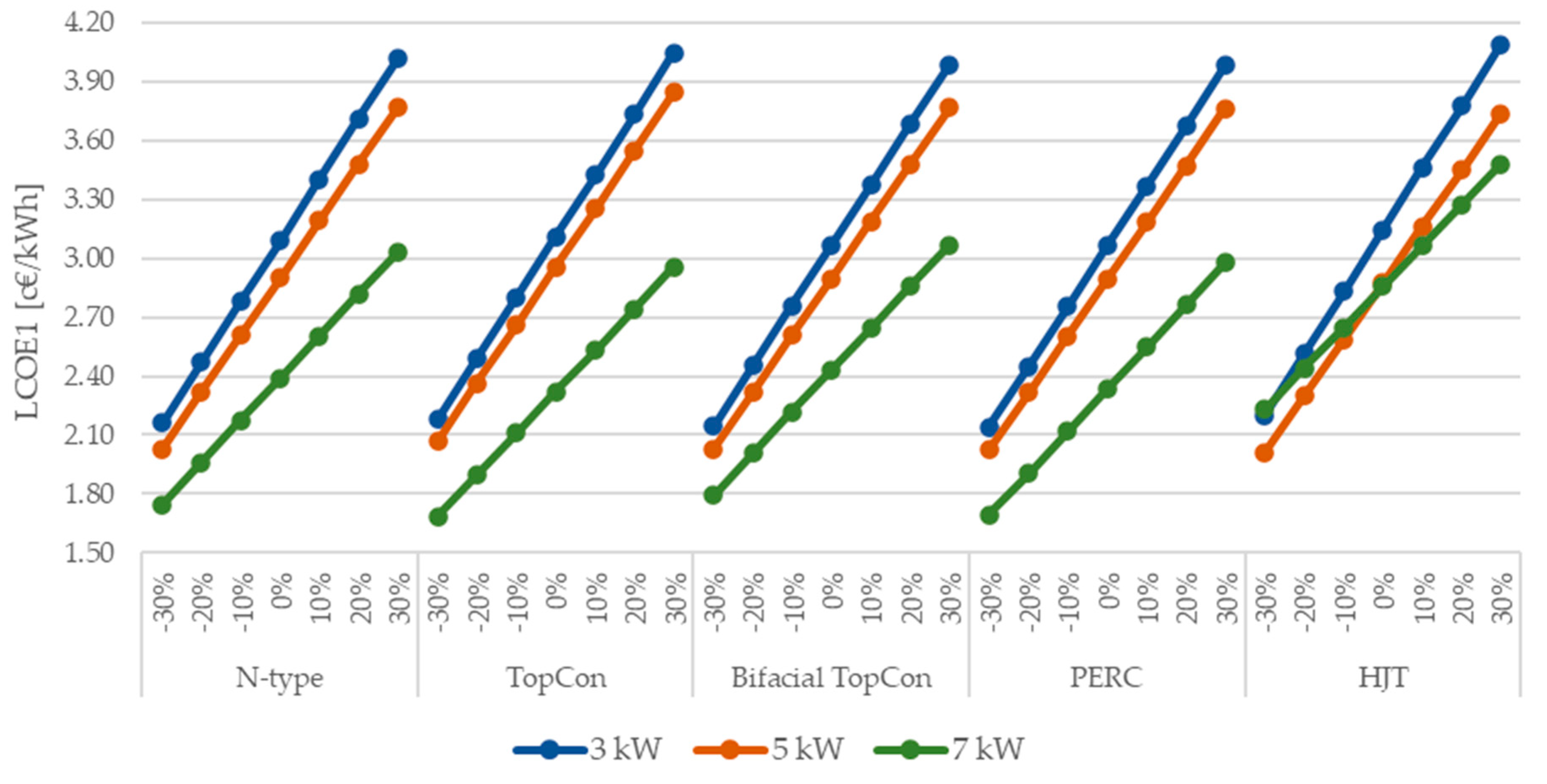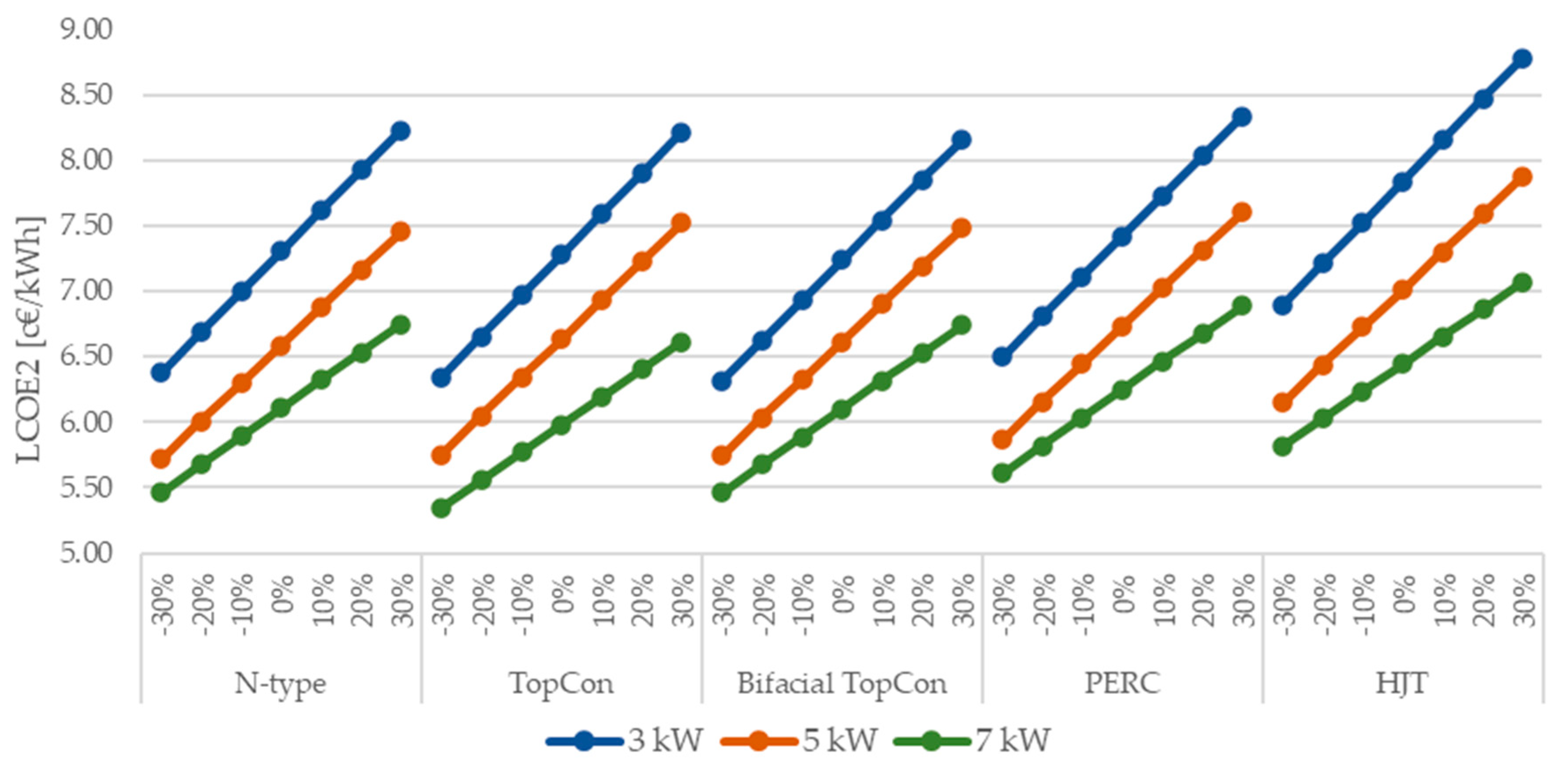Levelized Cost of Energy (LCOE) of Different Photovoltaic Technologies
Abstract
1. Introduction
2. Materials and Methods
2.1. PV Module Technologies Description
2.2. Proposed LCOE Methodology
3. LCOE Results and Discussion
4. Sensitivity Analysis
5. Conclusions
Author Contributions
Funding
Institutional Review Board Statement
Informed Consent Statement
Data Availability Statement
Acknowledgments
Conflicts of Interest
References
- International Renewable Energy Agency. Renewable Energy in Climate Change Adaptation: Metrics and Risk Assessment Framework. 2025. Available online: www.irena.org (accessed on 23 April 2025).
- International Energy Agency. Renewables. 2024. Available online: www.iea.org (accessed on 22 April 2025).
- Kousovista, G.; Iakovides, G.; Petridis, S.; Chairopoulos, N.-C.; Skembris, A.; Fotopoulou, M.; Antipa, D.; Nikolopoulos, N.; Rakopoulos, D. Comparative Lifecycle Assessment of Renewable Energy Investments in Public Buildings: A Case Study of an Austrian Kindergarten Under Atypical Operational Conditions. Appl. Sci. 2025, 15, 2330. [Google Scholar] [CrossRef]
- Almasri, R.A.; Eid, A.; Almarshoud, A.F.; Almotairy, F.H. Assessment of Energy Use and Photovoltaic Energy Potential in Saudi Arabian Governmental Schools. Appl. Sci. 2025, 15, 3809. [Google Scholar] [CrossRef]
- Başaran, K.; Özdemir, M.T.; Bayrak, G. Sizing and Techno-Economic Analysis of Utility-Scale PV Systems with Energy Storage Systems in Factory Buildings: An Application Study. Appl. Sci. 2025, 15, 3876. [Google Scholar] [CrossRef]
- Fratean, A.; Dobra, P. Technical and economic viability of greenfield large scale photovoltaic plants in Romania. Sustain. Energy Technol. Assess. 2022, 53, 102486. [Google Scholar] [CrossRef]
- Yang, Q.; Li, H.; Li, T.; Zhou, X. Wind farm layout optimization for levelized cost of energy minimization with combined analytical wake model and hybrid optimization strategy. Energy Convers. Manag. 2021, 248, 114778. [Google Scholar] [CrossRef]
- Obi, M.; Jensen, S.M.; Ferris, J.B.; Bass, R.B. Calculation of levelized costs of electricity for various electrical energy storage systems. Renew. Sustain. Energy Rev. 2017, 67, 908–920. [Google Scholar] [CrossRef]
- Nieto-Díaz, B.A.; Crossland, A.F.; Groves, C. A levelized cost of energy approach to select and optimise emerging PV technologies: The relative impact of degradation, cost and initial efficiency. Appl. Energy 2021, 299, 117302. [Google Scholar] [CrossRef]
- Bano, T.; Rao, K.V.S. Levelized Electricity Cost of Five Solar Photovoltaic Plants of Different Capacities. Procedia Technol. 2016, 24, 505–512. [Google Scholar] [CrossRef][Green Version]
- Chong, S.; Wu, J.; Chang, I.-S. Cost accounting and economic competitiveness evaluation of photovoltaic power generation in China——based on the system levelized cost of electricity. Renew. Energy 2024, 222, 119940. [Google Scholar] [CrossRef]
- Branker, K.; Pathak, M.J.M.; Pearce, J.M. A review of solar photovoltaic levelized cost of electricity. Renew. Sustain. Energy Rev. 2011, 15, 4470–4482. [Google Scholar] [CrossRef]
- Manzolini, G.; Gentile, G.; Pilotti, L.; Martelli, E.; Picotti, G.; Binotti, M.; Cholette, M.E. Limitations of using LCOE as economic indicator for solar power plants. Renew. Sustain. Energy Rev. 2025, 209, 115087. [Google Scholar] [CrossRef]
- Wang, Q.; Guo, K.; Gu, S.; Huang, W.; Peng, H.; Wu, W.; Ding, J. Electrical Performance, Loss Analysis, and Efficiency Potential of Industrial-Type PERC, TOPCon, and SHJ Solar Cells: A Comparative Study. Prog. Photovolt. Res. Appl. 2024, 32, 889–903. [Google Scholar] [CrossRef]
- Lazaroiu, A.C.; Osman, M.G.; Strejoiu, C.-V.; Lazaroiu, G. A Comprehensive Overview of Photovoltaic Technologies and Their Efficiency for Climate Neutrality. Sustainability 2023, 15, 16297. [Google Scholar] [CrossRef]
- Ren, J.; Zhao, W.; Shi, J.; Yan, Z.; Chen, S.; Luo, Y.; Wang, G.; Han, A.; Shi, Q.; Xia, Z.; et al. Predicting the lifetime of HJT modules towards the outdoor real-world environment. Sol. Energy Mater. Sol. Cells 2024, 272, 112885. [Google Scholar] [CrossRef]
- Li, D.; Liu, P.; Fu, N.; Wu, G.; Ju, X. The Research and Development of N Type Monocrystalline Silicon Wafer for High Efficiency Solar Cells. In Proceedings of the 2016 China Semiconductor Technology International Conference (CSTIC), Shanghai, China, 13–14 March 2016; IEEE: Piscataway, NJ, USA, 2016. [Google Scholar]
- Metz, A.; Adler, D.; Bagus, S.; Blanke, H.; Bothar, M.; Brouwer, E.; Dauwe, S.; Dressler, K.; Droessler, R.; Droste, T.; et al. Industrial high performance crystalline silicon solar cells and modules based on rear surface passivation technology. Sol. Energy Mater. Sol. Cells 2014, 120 Part A, 417–425. [Google Scholar] [CrossRef]
- Banerjee, S.; Sarkar, K.; Das, H.S.; Maity, H.; Bidwe, R.V. A Brief Review of TOPCon Solar Cell and its Future Perspectives. In Proceedings of the 2024 IEEE International Conference on Communication, Computing and Signal Processing, IICCCS 2024, Asansol, India, 19–20 September 2024; Institute of Electrical and Electronics Engineers Inc.: Piscataway, NJ, USA, 2024. [Google Scholar] [CrossRef]
- Mahim, T.M.; Rahim, A.H.M.A.; Rahman, M.M. Review of Mono-and Bifacial Photovoltaic Technologies: A Comparative Study. IEEE J. Photovolt. 2024, 14, 375–396. [Google Scholar] [CrossRef]
- Wang, L.; Tang, Y.; Zhang, S.; Wang, F.; Wang, J. Energy yield analysis of different bifacial PV (photovoltaic) technologies: TOPCon, HJT, PERC in Hainan. Solar Energy 2022, 238, 258–263. [Google Scholar] [CrossRef]
- Kılıç, U.; Kekezoğlu, B. A review of solar photovoltaic incentives and Policy: Selected countries and Turkey. Ain Shams Eng. J. 2022, 13, 101669. [Google Scholar] [CrossRef]
- Chowdhury, M.S.; Rahman, K.S.; Chowdhury, T.; Nuthammachot, N.; Techato, K.; Akhtaruzzaman, M.; Tiong, S.K.; Sopian, K.; Amin, N. An overview of solar photovoltaic panels’ end-of-life material recycling. Energy Strategy Rev. 2020, 27, 100431. [Google Scholar] [CrossRef]
- Sah, D.; Chitra; Kumar, S. Recovery and analysis of valuable materials from a discarded crystalline silicon solar module. Sol. Energy Mater. Sol. Cells 2022, 246, 111908. [Google Scholar] [CrossRef]
- Duffie, J.A.; Beckman, W.A.; Blair, N. Solar Engineering of Thermal Processes, Photovoltaics and Wind; Wiley: Hoboken, NJ, USA, 2020. [Google Scholar] [CrossRef]
- Valentin Software. PV*SOL Premium 2025, Valentin Software: R5. Available online: https://valentin-software.com/en/products/pvsol-premium/ (accessed on 2 April 2025).
- The National Agency for Fiscal Administration (ANAF). Law No. 227/2015 on the Fiscal Code, as Later Amended and Expanded, Romania. 2015. Available online: https://static.anaf.ro/static/10/Anaf/legislatie/L_227_2015.htm#T7C8 (accessed on 8 June 2025).
- Mostafa, M.H.; Aleem, S.H.E.A.; Ali, S.G.; Ali, Z.M.; Abdelaziz, A.Y. Techno-economic assessment of energy storage systems using annualized life cycle cost of storage (LCCOS) and levelized cost of energy (LCOE) metrics. J. Energy Storage 2020, 29, 101345. [Google Scholar] [CrossRef]
- Romanian Government. Order No. 2045/2024 of the Ministry of Environment, Water, and Forests of Romania for the Amendment of the Program Regarding the Installation of Photovoltaic Panel Systems for the Production of Electricity, in Order to Cover the Consumption Needs and Deliver the Surplus to the National Grid. 2024. Available online: https://www.afm.ro/sisteme_fotovoltaice_ghid_finantare.php (accessed on 3 May 2025).
- Cristea, M.; Cristea, C.; Tîrnovan, R.-A.; Botezan, A.; Şerban, F.; Balog, E. Analysis of Levelized cost of storage for a prosumer—Case study: Romania. In Proceedings of the EPEi 2024—Proceedings of the 2024 13th IEEE International Conference and Expositions on Electric and Power Engineering, Iasi, Romania, 17–19 October 2024; Institute of Electrical and Electronics Engineers Inc.: Piscataway, NJ, USA, 2024; pp. 693–696. [Google Scholar] [CrossRef]
- The Official Gazette of Romania. Order No. 3694/785/2024 on the Revision of the Discount Rate to be Used in the Public Procurement Contracts in 2025. 2025. Available online: https://lege5.ro/Gratuit/ge3dcmbqgyyti/ordinul-nr-3694-785-2024-privind-revizuirea-ratei-de-actualizare-ce-va-fi-utilizata-la-atribuirea-contractelor-de-achizitie-publica-in-anul-2025 (accessed on 13 May 2025).









| HJT | N-Type | PERC | TOPCon | Bifacial TOPCon | ||
|---|---|---|---|---|---|---|
| Module installed power [W] | 430–710 | 415–600 | 550–670 | 435–615 | 430–700 | |
| Efficiency [%] | 21.6–25.6 | 21–23.10 | 21.2–21.7 | 21.1–22.8 | 22–23 | |
| Module area [m2] | 1.95–3.11 | 1.95–2.63 | 2.51–3.11 | 1.95–2.70 | 1.95–3.11 | |
| Number of PV modules [pcs] | 3 kW | 5–7 | 5–8 | 5–6 | 5–7 | 5–7 |
| 5 kW | 8 -12 | 9–13 | 8–10 | 8–12 | 9–12 | |
| 7 kW | 14–17 | 12–17 | 11–13 | 10–17 | 12–17 | |
| Calendar life [years] | 30 | 25–30 | 25 | 25–30 | 30 | |
| City | Annual Sum of Global Irradiation [kWh/Year/m2] |
|---|---|
| Arad | 1278 |
| Bacău | 1299 |
| Baia Mare | 1253 |
| Bistrița | 1295 |
| Botoșani | 1266 |
| Brașov | 1384 |
| București | 1410 |
| Buzău | 1362 |
| Călărași | 1410 |
| Câmpulung Moldovenesc | 1241 |
| Caransebeș | 1325 |
| Cluj-Napoca | 1300 |
| Constanța | 1443 |
| Craiova | 1408 |
| Drobeta-Turnu Severin | 1357 |
| Galași | 1398 |
| Iași | 1342 |
| Oradea | 1264 |
| Râmnicu Vâlcea | 1391 |
| Satu Mare | 1253 |
| Sibiu | 1360 |
| Suceava | 1260 |
| Sulina | 1413 |
| Tîrgu Mureș | 1335 |
| Timișoara | 1326 |
| Tulcea | 1398 |
| CI [€/kW] | OM [€/Year] | SPV [€] | ||||
|---|---|---|---|---|---|---|
| Range | IQR | Avg | ||||
| HJT | 3 kW | 643–831 | 733 | 724 | 132 | 4018 |
| 5 kW | 573–739 | 634 | 640 | 203 | ||
| 7 kW | 606–764 | 662 | 675 | 203 | ||
| N-Type | 3 kW | 587–771 | 620 | 633 | 132 | |
| 5 kW | 511–670 | 548 | 555 | 203 | ||
| 7 kW | 562–698 | 592 | 597 | 203 | ||
| PERC | 3 kW | 577–679 | 611 | 614 | 132 | |
| 5 kW | 495–594 | 544 | 543 | 203 | ||
| 7 kW | 555–611 | 577 | 581 | 203 | ||
| TOPCon | 3 kW | 551–672 | 632 | 621 | 132 | |
| 5 kW | 519–590 | 545 | 550 | 203 | ||
| 7 kW | 538–604 | 583 | 579 | 203 | ||
| Bifacial TOPCon | 3 kW | 572–688 | 632 | 630 | 132 | |
| 5 kW | 517–656 | 552 | 563 | 203 | ||
| 7 kW | 550–667 | 597 | 602 | 203 | ||
| Model Year | LCOE [c€/kWh] | Installed Power | PV Technology | Country |
|---|---|---|---|---|
| [9] 2021 | 13 | 5.5 MW | organic absorber layers | Fiji |
| 19 | perovskite absorber layers | |||
| [10] 2016 | 12 | 1 MW | not specified | India |
| 6.3 | 5 MW | |||
| 7.3 | 10 MW | |||
| 5.9 | 25 MW | |||
| 6.1 | 151 MW | |||
| [11] 2024 | 6.7–15 | around 100 MW | not mentioned | China |
| [12] 2011 | 7.6–13 | residential | not specified | North America |
| 8.8–44 | commercial | |||
| 5.5–40 | utility scale | |||
| [13] 2025 | 5.2–13 | variable | not mentioned | South Australia |
| 4.9–7.9 | variable | Southern California (United States) | ||
| Proposed—with incentives | 2.46–3.19 | 7 kW 5 kW 3 kW | N-type | Romania |
| 2.39–3.21 | TOPCon | |||
| 2.50–3.16 | Bifacial TOPCon | |||
| 2.41–3.16 | PERC | |||
| 2.92–3.24 | HJT | |||
| Proposed—without incentives | 6.18–7.40 | 7 kW 5 kW 3 kW | N-type | Romania |
| 6.05–7.38 | TOPCon | |||
| 6.17–7.33 | Bifacial TOPCon | |||
| 6.32–7.52 | PERC | |||
| 6.51–7.94 | HJT |
Disclaimer/Publisher’s Note: The statements, opinions and data contained in all publications are solely those of the individual author(s) and contributor(s) and not of MDPI and/or the editor(s). MDPI and/or the editor(s) disclaim responsibility for any injury to people or property resulting from any ideas, methods, instructions or products referred to in the content. |
© 2025 by the authors. Licensee MDPI, Basel, Switzerland. This article is an open access article distributed under the terms and conditions of the Creative Commons Attribution (CC BY) license (https://creativecommons.org/licenses/by/4.0/).
Share and Cite
Cristea, M.; Cristea, C.; Tîrnovan, R.-A.; Șerban, F.M. Levelized Cost of Energy (LCOE) of Different Photovoltaic Technologies. Appl. Sci. 2025, 15, 6710. https://doi.org/10.3390/app15126710
Cristea M, Cristea C, Tîrnovan R-A, Șerban FM. Levelized Cost of Energy (LCOE) of Different Photovoltaic Technologies. Applied Sciences. 2025; 15(12):6710. https://doi.org/10.3390/app15126710
Chicago/Turabian StyleCristea, Maria, Ciprian Cristea, Radu-Adrian Tîrnovan, and Florica Mioara Șerban. 2025. "Levelized Cost of Energy (LCOE) of Different Photovoltaic Technologies" Applied Sciences 15, no. 12: 6710. https://doi.org/10.3390/app15126710
APA StyleCristea, M., Cristea, C., Tîrnovan, R.-A., & Șerban, F. M. (2025). Levelized Cost of Energy (LCOE) of Different Photovoltaic Technologies. Applied Sciences, 15(12), 6710. https://doi.org/10.3390/app15126710










